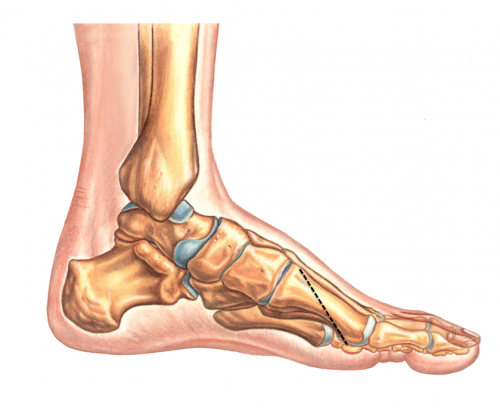Ludloff Procedure
(Bunion Surgery)
Edited by Daniel Farber, MD
Indications
The Ludloff procedure is a surgical technique that can be used to correct a moderately severe bunion (hallux valgus) deformity that has failed nonoperative treatment. Dr. Ludloff first described it in 1918. The surgery is performed by making an oblique (slanted) cut (osteotomy) in the bone (first metatarsal) that leads to the great toe (Figure 1). The cut bone is then rotated to correct the bunion deformity (decrease the 1-2 intermetatarsal angle). This procedure is combined with an operation to realign the great toe itself. This is done by loosening the joint capsule on the outside of the great toe and then tightening up the joint capsule on the inside of the great toe.
Procedure
The Ludloff procedure itself involves making a cut (incision) on the top or inside of the foot to expose the long bone (first metatarsal) that leads to the great toe. Once this bone is exposed, it is cut obliquely and, prior to completing the cut, a screw is placed but not tightened to hold the bone partially in position. The bone is then rotated around the screw so that the far end of the bone (first metatarsal) is in an improved position, lessening the bunion deformity. The screw is tightened and the bone is further stabilized with other screws or occasionally a plate. The great toe joint is then corrected in an improved position by loosening the outside ligaments and tightening up the joint capsule on the inside (medial).
Figure 1: Ludloff Bone Cut

Recovery from the Ludloff Procedure
Success of the Ludloff procedure requires healing of the cut bone and this healing usually takes six weeks or longer. During this healing period, it is not usually possible to put all your weight on the foot, requiring some weight bearing through the heel, and limited walking in a stiff soled shoe or boot. Once the bone is fully healed, activity can be increased. It is important to keep the great toe joint moving with some special exercises. Often by 8 to 12 weeks post surgery, it is possible for the patient to return to a normal shoe, usually with a wide toe box. For many patients, the big toe often remains slightly swollen for up to a year. Tight shoes and narrow toe shoes should be avoided after this surgery.
Potential Complications
General Complications
Although uncommon, there are a variety of complications that can occur. These include:
- Infection
- Wound healing problems
- Blood Clots: Deep vein thrombosis (DVT) or Pulmonary Embolism (PE).
- Specific Complications of the Ludloff Procedure
Specific Complications
- Nerve Injury: Injury to the nerve that supplies sensation to the inside of the great toe (Medial branch of the superficial peroneal nerve) may occur. In addition, the nerve that supplies the space between the first and the second toe (deep peroneal nerve) may also be injured. An injury to these nerves may lead to numbness or a burning type pain. Very rarely, a nerve injury may lead to the development of a complex regional pain syndrome.
- Delayed union or Non-Union: There is also a possibility that the bone that is cut (first metatarsal) may heal slowly or not at all. If it does not heal, further surgery may be required.
- Malunion: A malunion occurs when the bone heals in an unacceptable position. In this situation, further surgery may be necessary.
- Recurrence of the Bunion Deformity: Occasionally, the bunion deformity may return following a Ludloff procedure. This can occur over time or relatively quickly and may require revision surgery.
- Hallux Varus Deformity: An overcorrection of the bunion (hallux varus), where the great toe points away from the other toes. This can lead to increased symptoms of pain and deformity.
- Stiffness: There may be some loss of movement of the great toe joint after surgery due to scarring. This can be improved with physiotherapy. In some cases, the joint may go on to develop arthritis, which may require further surgery.
Edited March 28, 2018
Previously Edited by Peter Stavrou, MD
mf/3.5.18